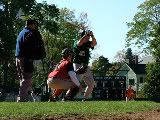I was a bit surprised to learn that it was a Worth glove. I had not known Worth to make baseball gloves at that time as the company was not listed as a glove manufacturer in the sporting goods publications that I researched of that date. But it could well have been. Another surprising thing I uncovered was that according to the Lannom Company (using Worth name for its baseball products) didn't start using the Worth name until 1921. That would have made it a little difficult for Wambsganss to be using a Worth glove in 1920. According to the description in Lelands, the
plant the glove was sent back to was in Iowa. The history of Worth shows that it began in Tullahoma where it still resides. It may have had a plant also in Iowa that made gloves. It may have also missed on its 1921 beginning date of marking its gloves. This might be the glove being auction. But questions arise. It is also not very comforting to see that whoever wrote the Wambsganss glove description spelled Lannom three ways (Lannon, Lannin) including two incorrectly and Mr. McDonald (or MacDonald), the glove's owner, spelled two ways with one of those having to be incorrect. Lelands needs to hire a proof reader. Here's the descirption from the Leland's web site:
"Update
The glove was a gift from Mr. Lannon to Mr MacDonald and Mr. Lannin did not leave it at Mr. McDonald’s house by accident as stated in the printed catalog.
One of the most famous events in World Series history took place in 1920 during game 5. In this game Cleveland's Bill Wambsganss completed the only unassisted triple play ever in the Fall Classic. Wambsganss, playing second base, caught a line drive off the bat of Clarence Mitchell stepped on second base to put out Pete Kilduff, and tagged Otto Miller coming from first base. The Indians went on to win the game, and eventually the series in seven games. Worth Professional model glove shows the type of use you expect to see back in the day when a glove would have been worn for an entire season or longer. The 3'' web between the thumb and forefinger is partially separated along the stitches to the forefinger. There is a hole in the palm between the forefinger and middle finger. The Worth label has major fraying and the glove has a vertical tear through the wrist band. There is also some oxidation to the metal grommets that hold the original string laces. The glove, however, is still soft and supple. The provenance is supported by two original letters and an 8 x 10'' photo that accompany the glove. The photo was taken just after the game and pictures Wamby wearing this very glove most evident by the placement of the patch on the wrist band and button on band. One letter, dated 1945, on Minneapolis Star Journal and Tribune letterhead, tells the owner that he should write to J Taylor Spink if he would like to place the glove in the Hall of Fame. The second letter, dated 1948, is more specific about the how the original owner, George McDonald, acquired the piece. It seems that following the 1920s World Series, Wamby sent the glove to Lannom Mfg Co (Worth Sporting Goods) in Iowa requesting that a duplicate of the glove me made. While they did make a new glove for him, they neglected to return this original. Mr. Lannom and Mr. McDonald were friends and the glove was a gift from Mr. Lannon to Mr MacDonald. As both of these letters show, Mr. McDonald had every intention of giving the glove to the Hall of Fame, but never did, giving today’s collecting community the opportunity to acquire this historically significant piece.
Reserve: $25,000
1912
George Sharp Lannom, Jr. purchases tannery in Tullahoma, TN and establishes Lannom Manufacturing Company.
1913
Major products: horse collars and harnesses.
1919
Company begins production of footballs & basketballs.
1920
Company begins production of baseballs.
1921
"Worth" adopted as baseball trademark.
Now Wambsganss is definitely wearing a glove the back of which does resemble the auctioned glove but it's shot at a great distance and patches were normally sewn onto many gloves the way it's pictured. Not quite sure what the description meant about the button. This is what virtually all glove companies used to fasten writst straps at this time. I've written to Worth Company to see if the company was making gloves by 1920.
I'd be interested in seeing what some of our forum member can come up with on this glove or what they think.



